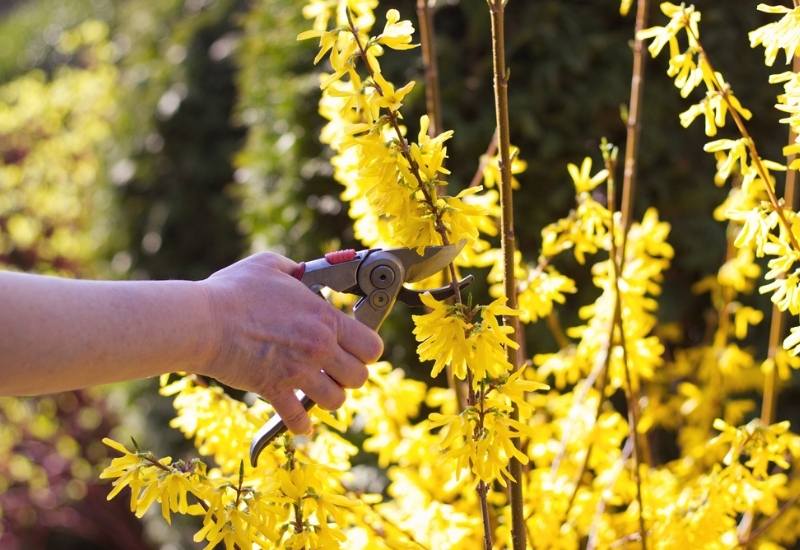
You will agree with me: most forsythia shrubs you see in private gardens just look “wrong” or even “ugly”. Why? It’s all down to pruning. Pruning forsythia the right way is, in fact, the main task you need to keep this amazing spring bloomer in good shape.
Having worked as a landscaping professional, I can confidently state that most people lack the necessary skills and knowledge to prune forsythia correctly.
Forsythia, a herald of spring, captivates with its vibrant blooms that delight the eye and lift the spirit. However, improper pruning can cause these shrubs to become overgrown, messy, and even unnatural-looking.
The quick and disorderly growth of forsythia, featuring branches arching in all directions, highlights the importance of proper pruning at the right time of year.
In fact, poorly executed pruning or incorrect timing can lead to cluttered, unsightly, and unnatural-looking forsythia shrubs that might encroach upon nearby garden spaces or even jeopardize the brilliance of next year’s floral show.
Pruning is an essential task that is critical to maintaining the health and beauty of forsythia, yet it’s all too easy to overlook or execute incorrectly. Don’t let this happen to your magnificent forsythia. Instead, arm yourself with a clear and professional step-by-step guide to pruning forsythia, complete with technical gardening tips.
Get ready to unleash the full potential of your forsythia and elevate it to a new level of beauty and vibrancy in your garden with these expert pruning techniques.
Why Pruning Your Forsythia is a Must-Do
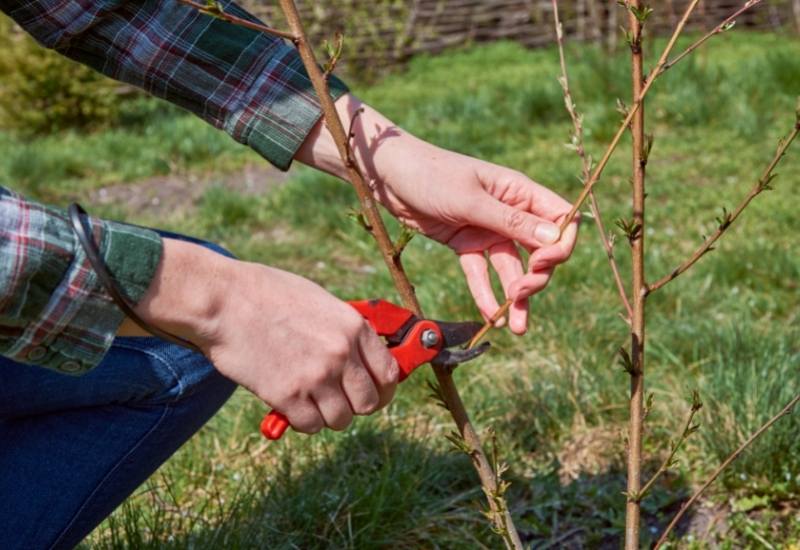
Forsythia is a massive bloomer, but also a very vigorous shrub. It announces spring with its huge yellow flower displays, but it can also become overgrown and unruly.
How many times have you looked at them in suburban gardens and seen an utter tangle of branches and leaves that makes no sense at all?
This is what you get if you don’t know how to prune it.
But there is more… Forsythia’s branches arch naturally and, as soon as they touch the ground, they grow roots and develop a new shrub from there.
For this reason, they can propagate spread very fast and vigorously, and, left to their own devices, they can take up a whole garden over the years. And you don’t want this to happen.
Next… Forsythias are very strong and they grow many branches; but this can become a real health hazard for them.
When the shrub is too dense, ventilation is poor, and this can cause disease, infections, fungal problems and even attract pests.
And finally, old forsythias have many large branches at the base; these rub against each other, causing lacerations and allowing entry points for infections. For this reason, you may need to cut some of them from the very base of the plant.
So, here are the three reasons why you should prune your forsythia every year.
But when exactly? We will see it right now.
Best Time to Prune Your Forsythia for Spectacular Blooms
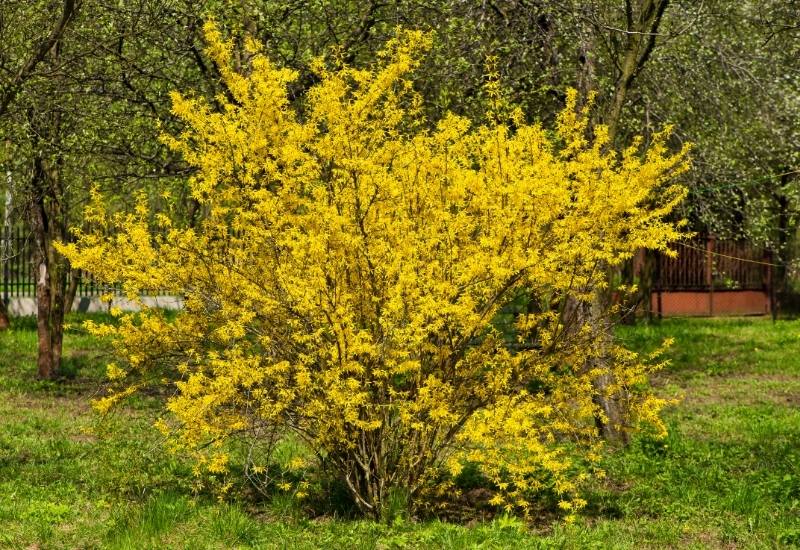
There is only one time when you can prune your forsythia successfully: soon after the bloom is spent. But how soon?
Put simply, within three weeks of the blooms wilting. As soon as you see the fresh green leaves growing in size, it’s time to grab those pruning shears and get to work.
You cannot delay, and there are two reasons for it:
So, do it when you can actually see the branches, and before it wastes energy in buds and branches that you will end up cutting.
But we said that people make many mistakes with pruning forsythia. Let’s go through them so yours won’t look like a messy tangle of branches…
Common Mistakes With Pruning Forsythia
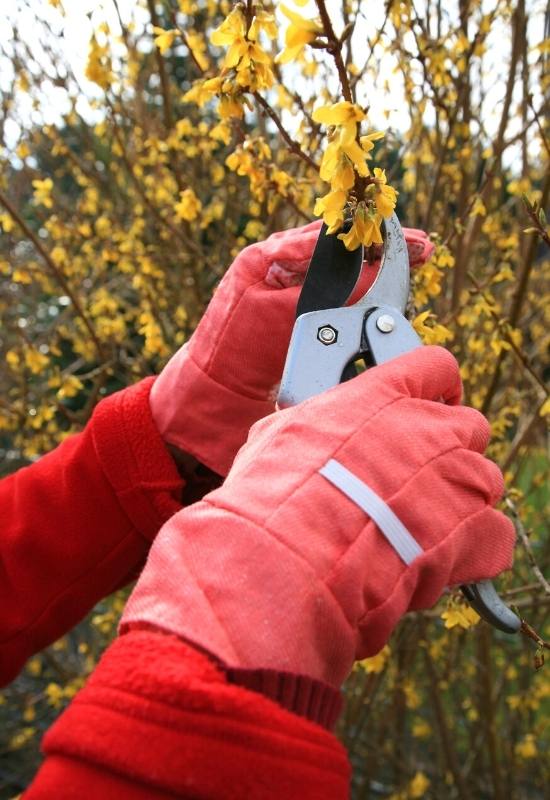
At the origin of all mistakes that people make with pruning forsythia is that they do not understand its nature… This shrub is so dense that many amateurs don’t understand that it actually has its own habit and natural shape.
If you go against it, you will only cause problems. Like with all pruning, you must work with the nature of the plant and not against it.
Let’s see these mistakes in detail.
Do Not Prune Your Forsythia into a Regular, Geometric Shape
Many people think that forsythia is like box or privet… It isn’t; it is a natural looking shrub that really does not suit formal hedges or neatly trimmed shapes. For this reason, you must never trim the edges of your forsythia.
That causes lots of lateral branches to develop, and they go inside the shrub, make it look tangled, and they can even cause health problems, as we have seen. And it really spoils the amazing beauty of this shrub.
Do Not Cut The Branches in the Middle
This is a related problem; if you want to reduce the size of your forsythia and you just cut the branches to half, one third, two thirds… you will get an awful mess of lateral branches that will try to grow out anyway.
So, do not try to reduce the natural size of your forsythia. Maybe this is why they look so bad in many small gardens. If you have a forsythia, you need to allow it to grow to its full height and spread. Otherwise, buy a small or dwarf variety.
Do Not Trim Your Forsythia Once It Has Restarted Growing
If you don’t prune your forsythia well after the bloom, it will still grow branches. It is tempting to try to trim it to keep it in size, for example in summer.
But this will give you the same result of a lot of new branches and, on top of that, these will not bloom next year, because they won’t have the time to develop the flower buds.
So, these are the mistakes that lead to those sad looking shrubs you see in many gardens…
Now, let’s look at the opposite perspective…
How To Work With Your Forsythia When Pruning It
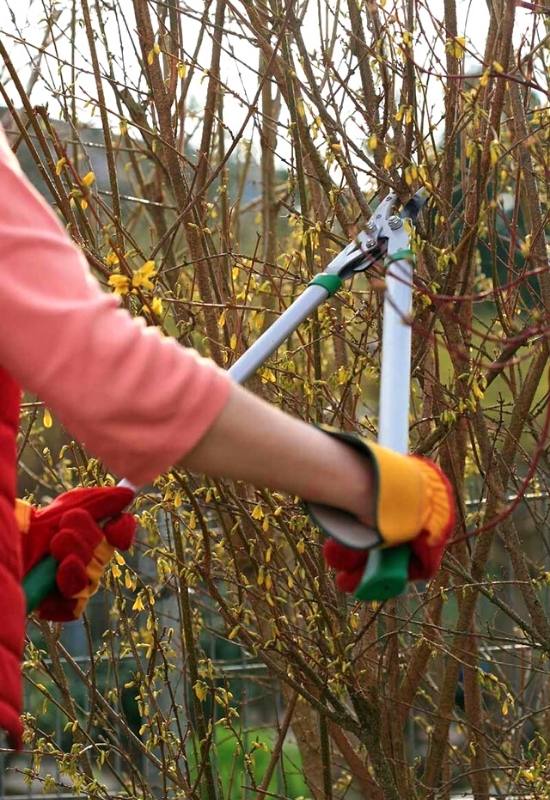
As we said, you need to understand the natural shape, habit and growth pattern of your forsythia to prune it correctly. And what is this?
Forsythias look like fountains. And this is the only shape you can have with this shrub. What you want is long branches that start from the base of the shrub or of a main branch and arch outwards. These will totally fill with blooms, and then you can cut back the ones you don’t want any more.
Some will have more upright branches, others will have mor arching ones, but you really want them to start low and then grow freely.
How Much of Your Forsythia You Should Prune Every Year
You can cut a lot of your forsythia, unlike other plants and trees, but on the whole aim to cut about one third of the branches each year.
And this does not mean to cut each branch by one third, but one third of each branch from its base. And this gives you a clue about how we do this…
Now, what tools will you need?
The Tools You Need To Prune Forsythia
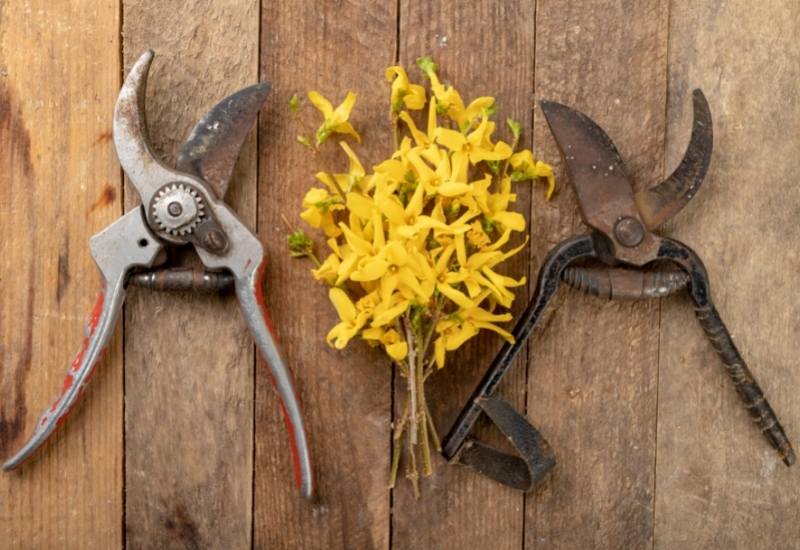
You will need some pruning tools, and small ones will simply not suffice… And here they are:
You will not need any shears (hand or electric), or other tools you use to trim hedges; as we said, you will be pruning, not trimming.
Also, for extra safety, use a disinfectant to sterilize your blades; apple cider vinegar or alcohol will do perfectly well.
And now, on to the practical instructions…
How To Prune Forsythia: A Step By Step Guide
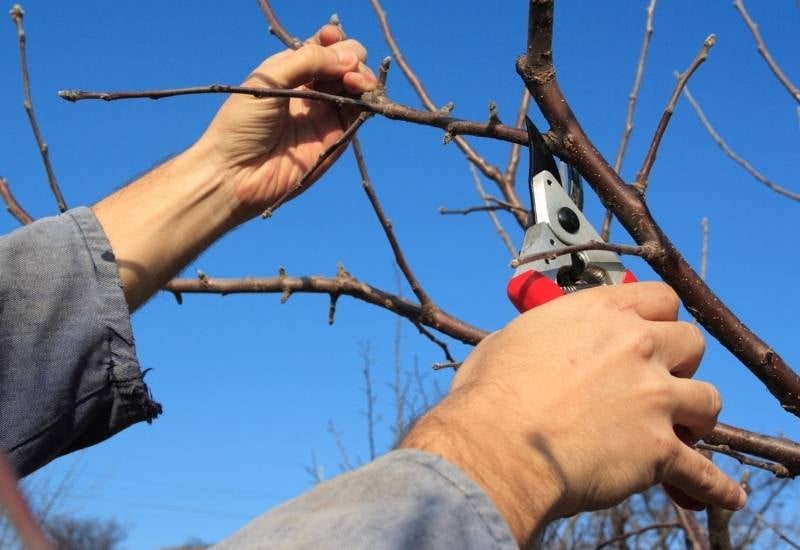
The way you prune forsythia every year depends on the age and maintenance conditions of your shrub.
This will determine how radically you can cut branches. And we will go through this process step by step with clear explanations.
How to Prune an Old Forsythia
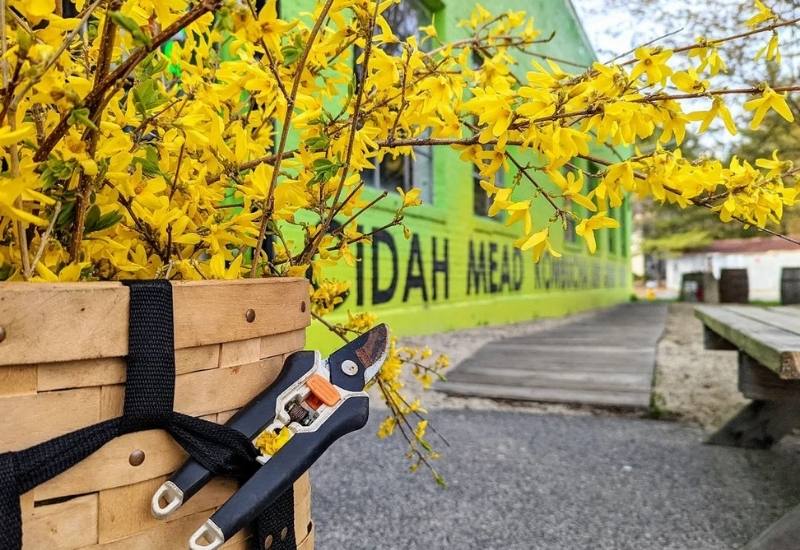
If your forsythia is old, and especially if it has not been pruned for a long time, you need to start with the big branches at the bottom of the shrub.
Now you the bulk of the heavy cutting is done, you can proceed with what you would do with younger forsythias. So, read on, and you will finish the job like a professional.
How to Prune a Young Forsythia
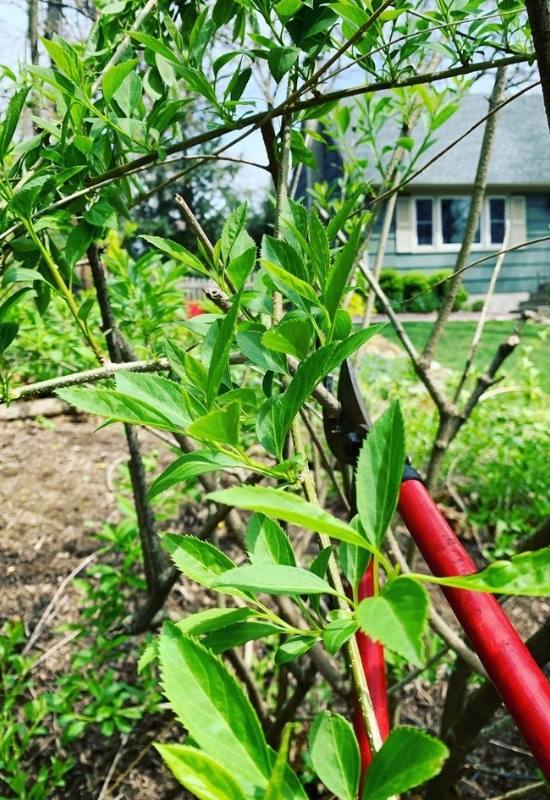
You won’t need to thin down the central bundle of stems in a young forsythia, but you still need to thin it, but you will mainly work on secondary branches.
You can still cut main branches if you think it is necessary, and you can even do it after you have carried out the standard pruning described below.
Finally, step back and have a look at your forsythia; now it is not covered with leaves, you will see its actual shape. Does it look like a neat fountain? Are there any minor adjustments to make.
That’s it! Just remove all the cut branches and your forsythia will be fine, harmonic, natural looking and healthy for a whole year!
Pruning Forsythia: Work With The Shrub, Not Against It!
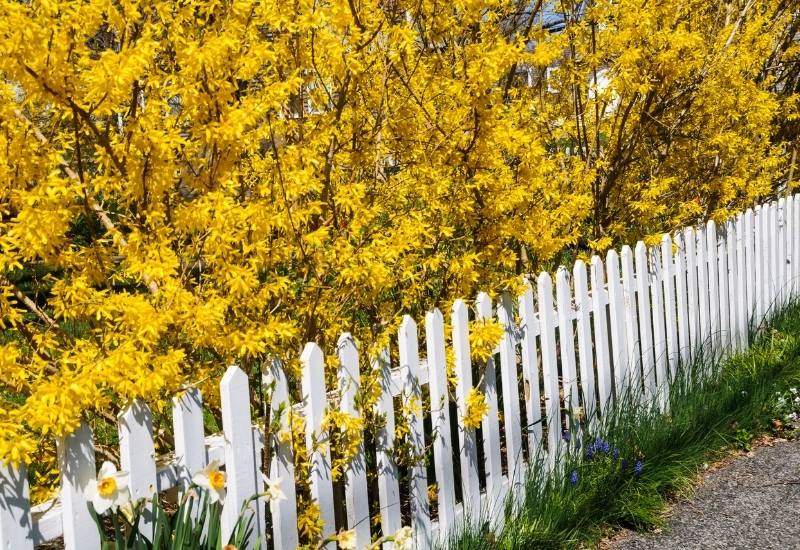
Forsythia is a shrub few amateurs know how to trim. And we can see the results. Keep in mind the key rules, like cutting each branch to its base, and, above all, respect the natural beauty and the will of your plant.
This is by far the most important principle of all pruning, and now you fan even try your hand with one of the touchstones of professionals!

Written By
Margie Fetchik
Margie and Arkansas native has an extensive background in gardening and landscaping. For the last 40 years, Margie has called the Colorado Rocky Mountains her home. Here she and her husband of 36 years raised three kids and owned a successful landscaping company. Margie has a CSU Master Gardener certification. She specialized in garden design & installation, perennial gardens, turf grasses & weeds, flower containers, and the overall maintenance of allHOA, commercial and residential accounts. She and her husband now reside in Denver and are excited about the new experiences’ city life holds.
